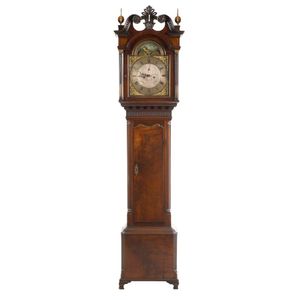George III Mahogany Longcase Clock by Wilkinson of London
You must be a subscriber, and be logged in to view price and dealer details.
Subscribe Now to view actual auction price for this item
When you subscribe, you have the option of setting the currency in which to display prices to $Au, $US, $NZ or Stg.
- George Iii - George III (1738 - 1820) was King of Great Britain and Ireland from 1760 to 1820.
- Hood - In longcase clocks, the hood is the wooden case that surrounds the works and dial, and includes the glass front, which is usually hinged, so the door can be opened to wind the clock or adjust the time. In 18th and 19th century longcase clocks the hood usually slides forward for removal, allowing access to the works.
- Chapter Ring - A separate metal plate on the face of a clock, on which the numerals for the hours and sometimes parts of the hours, are displayed, usually wheel shaped and sitting on top of the dial plate. The chapter ring is often a feature of the clock and can be silvered or enamelled to stand as a contrast to its background. The hours are usually shown in Roman numerals, although in the late 19th and earlt 20th century, Arabic numerals became fashionable.
- Movement - The technical name for the workings of a clock or watch, and does not include the dial or case.
- Date Aperture - A date aperture is a cut out section in the face of a watch or clock, displaying the day of the month.
- Mahogany - Mahogany is a dense, close grained red-coloured timber from the West Indies and Central America. It was first imported into Europe in the the early 18th century and its use continued through the 19th century. It was popular for furniture making because of its strength, the wide boards available, the distinctive grain on some boards, termed flame mahogany and the rich warm colour of the timber when it was polished.. The "flame" was produced where a limb grew out from the trunk of the tree, and this timber was usually sliced into veneers for feature panels on doors, backs and cornices.
Some terms used to describe mahogany relate to the country from which it originally came, such as "Cuban" mahogany, "Honduras" mahogany etc. However unless the wood has been tested the names assigned are more a selling feature, rather than a true indication of the timber's origin.
This item has been included into following indexes:
Visually similar items

A mahogany longcase clock, by John Aspinwall Liverpool, circa 1800, circular silvered dial framed by pierced spandrels, foliate engraved centre with subsidiary seconds dial and concentric calendar, signed John Aspinwall, Liverpool. The upper arch displays

A Georgian period mahogany long case clock with phases of the moon arch dial, the silvered chapter ring with Roman numerals, gilt angel's head spandrels and calendar aperture, the arched hood with decorated with gilded glass panels and supporting flying ea

A Georgian flame mahogany longcase clock, c.1830, by Taylor of Darlington featuring a break-arched hood with fluted columns topped by moulded brass capitals, with painted dial, and subsidiary dials for seconds and dates, cock-beaded door and cross banded r

A mahogany longcase clock by Percival Mann, London, circa 1790, contained within a mahogany case the swan neck pediment carved with fret work and rosettes, the hood and case with reeded pilasters, the glazed hood enclosing an arch dial with moon face marke
